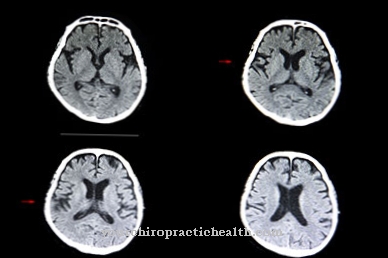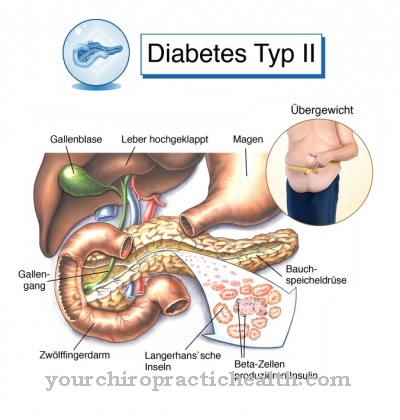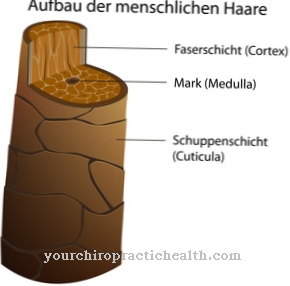Under the Shy-Drager syndrome the doctor describes an extremely rare disease of the vegetative or autonomic nervous system. Shy-Drager syndrome therefore falls into the category of neurological diseases. However, the term Shy-Drager syndrome is rarely used these days; Doctors primarily refer to the syndrome as Multiple system atrophy (short: MSA).
What is Shy-Drager Syndrome?

© nerthuz - stock.adobe.com
The Multiple system atrophy (MSA) or also Shy-Drager syndrome called, occurs predominantly in middle adulthood. The term MSA summarizes several clinical pictures that were considered a separate disease a few years ago.
For this reason, the names are Shy-Drager syndrome or the Striatonigral degeneration or also the Sporadic olivo ponto cerebellar atrophy Concepts of the past. Every year about 4 in 100,000 people develop multiple system atrophy.
causes
It is not yet known why and why multiple system atrophy develops. Experts mainly subdivide atypical Parkinson's syndrome according to the neuropathological findings, so that certain criteria are sought that could have been the trigger for multiple system atrophy.
As a rule, however, these criteria can only be determined after the patient's death; Here, however, the doctors are still researching in an unknown area, but using a microscope to try to find an answer to why so-called multi-system atrophy has broken out.
Symptoms, ailments & signs
Multi-system atrophy manifests itself in coordination disorders or the patient complains of motor disorders; Doctors also repeatedly speak of the so-called "penguin walk". In addition, those affected complain of sensory and sensory disorders and occurring paralysis, swallowing difficulties and language problems.
Further symptoms are personality changes, severe tremors, muscle weakness as well as fatigue and tension. As a result, spasticity and nystagmus (eye tremors) can occur.Those affected are relatively often tired, suffer from depression and inner restlessness.
Diagnosis & course of disease
During the diagnosis, the doctor mainly pays attention to the anamnesis or rather. he then conducts a clinical examination. The description of the symptoms as well as the doctor's observation are usually reasons that the doctor relatively quickly suspects that it could be a question of multiple system atrophy.
Above all, the combinations of autonomic disorders, which are usually reminiscent of Parkinson's symptoms, are a clear indication that the patient suffers from multiple system atrophy. However, it should be noted that multi-system atrophy - due to its similarity to Parkinson's syndromes - is relatively difficult to determine. Specialists, too, often have difficulties in making a dedicated commitment to multiple system atrophy.
The autonomic regulation disorders of the patient are predominantly obligatory. Many symptoms can or do not appear, making diagnosis more difficult. If there are actually difficult cases that make it impossible for the doctor to be sure that the problem is multiple system atrophy, imaging tests can help. The doctor relies on computed tomography, magnetic resonance tomography or the IBZM-SPECT.
Using CT or MRI, it is possible to examine the atrophied brain regions. The IBZM-SPECT makes it possible to determine whether any dopamine receptors are missing. If the physician is unsure, those imaging procedures should provide evidence that multiple system atrophy is present.
According to the medical profession, the autonomic disorders of the autonomic nervous system include bodily processes that are not knowingly regulated by humans. These include, for example, blood pressure regulation, emptying the bladder, as well as sleeping, swallowing and speaking. Those areas can cause problems due to the multiple system atrophy. The main problem with the disease is that malfunctions sometimes lead to food residues getting into the lungs.
As a result, pneumonia develops or aspiration pneumonia can also trigger a potentially life-threatening condition. Many patients who suffer from multiple system atrophy have already died as a result of aspiration pneumonia. The disease progression of multiple system atrophy is usually negative; Especially in the advanced stage there is no chance of a cure or survival of the multiple system atrophy.
Complications
First and foremost, Shy-Drager syndrome leads to severe disorders of coordination and concentration. These complaints have a very negative effect on the quality of life of the person concerned and can lead to significant restrictions in everyday life. Paralysis or disorders of sensitivity can also occur and are often accompanied by speech or swallowing difficulties.
As a result, the normal intake of food and fluids is no longer possible for the patient. Shy-Drager syndrome can also lead to changes in consciousness and personality, although in severe cases those affected can completely lose consciousness. It also leads to permanent tiredness and fatigue.
Most of those affected appear tense, and they suffer from tremors and restlessness. Psychological complaints or depression can also occur. Shy-Drager syndrome is usually treated with the help of medication.
There are usually no complications. If normal nutrition is no longer possible, it must be taken through a gastric tube. In some cases, however, Shy-Drager syndrome can also lead to death.
When should you go to the doctor?
Medical treatment is always necessary for Shy-Drager syndrome. As a rule, self-healing cannot occur, so that the person affected is dependent on treatment by a doctor so that there is no reduced life expectancy. A doctor should be consulted if the patient suffers from severe emotional disorders. The sensitivity in the organs drops significantly, so that paralysis or language problems can also occur.
Symptoms when swallowing can also indicate Shy-Drager syndrome and should definitely be examined and treated by a doctor. Many people affected appear tired and depressed as a result of the disease and suffer from muscle weakness or severe tremors. Furthermore, depression or inner restlessness can also indicate Shy-Drager syndrome and should also be examined and treated by a doctor.
The first diagnosis of Shy-Drager syndrome can be made by a family doctor. For further treatment, however, a visit to a specialist is necessary. It cannot be universally predicted whether a complete healing can occur.
Therapy & Treatment
The therapy is multi-pronged, is individually adapted and proves to be quite difficult - since the multi-system atrophy can be different. About a third of those affected actually respond to therapy. Doctors mainly resort to L-Dopa therapy, which is also used in Parkinson's patients. However, this therapy only helps for a certain period of time. Amantadine is also often prescribed; this is a drug that is supposed to help patients with movement disorders.
The physician must treat all known autonomic disorders symptomatically. It is important that the patient drinks enough fluids or is given blood pressure medication, as those affected not only suffer from voiding disorders, but sometimes also from very low blood pressure. If the doctor has already diagnosed a depression that has occurred in the context of multiple system atrophy, it must also be treated.
In many cases, incontinence also occurs; that too is treated symptomatically. In order to alleviate the suffering of the patient, if the disease has already reached the advanced stage, a nasogastric tube is inserted or the patient is ventilated using a breathing mask. So far there has been no addressing of the causes; However, research is currently being carried out into a therapy that primarily deals with the administration of immunoglobulins. Therapy is based on relieving symptoms, not tackling the cause.
You can find your medication here
➔ Medicines for painprevention
Since no cause is known so far, there is currently no possibility of preventive measures.
Aftercare
In Shy-Drager syndrome, those affected have very few measures and options for follow-up care in most cases. Therefore, the person affected should consult a doctor at an early stage so that there are no complaints or complications in the further course that could continue to have a negative effect on the quality of life of the person concerned.
Since it is a genetic disease, there is no complete cure. However, if the person concerned should first and foremost undergo genetic testing and counseling, in order to prevent the reoccurrence of Shy-Drager syndrome in their offspring. Many of the symptoms can be relieved and limited relatively well by taking various medications.
The regular intake and the correct dosage must always be observed in order to properly limit the symptoms. If you have any questions or side effects, you should always consult a doctor first. Furthermore, regular checks are very important throughout the life of the person affected in order to detect other damage to the body at an early stage. In some cases, Shy-Drager syndrome also reduces the life expectancy of those affected.
You can do that yourself
The causes of Shy-Drager syndrome are unfortunately still unknown. Therefore, a cure or slowing down of the disease is currently not possible. Living with Shy-Drager syndrome means allowing and using adapted aids as the corresponding restrictions increase. Physical incoordination, tremors and muscle weakness should be improved and accompanied with physiotherapy treatments.
Nursing aids, which are used for locomotion, can enable and promote participation in social life over a certain period of time. Increasing linguistic restrictions should be improved or kept stable as far as possible by accompanying speech therapy treatments. This means that communication with restrictions remains possible for a while.
With regard to restlessness and depression, movements and light sporting activities are of course recommended within the scope of the patient's possibilities. In this context, occupational therapy and occupational therapy measures such as music therapy, fragrance therapy, aromatherapy and Snoezelen should also be used.
Since it is no longer possible for the patient to take in food and fluids at a later stage, everyday aids with handouts are necessary. The changes in consciousness and personality as a whole should be discussed with the patient's immediate environment. This is the only way to adequately respond to behaviors that trigger incomprehension.
























.jpg)


